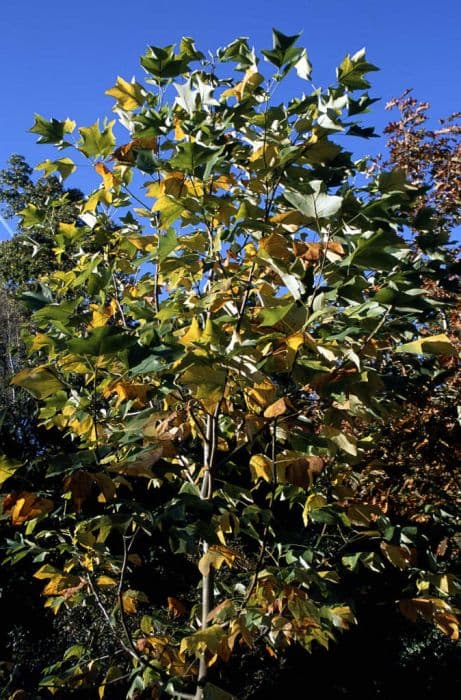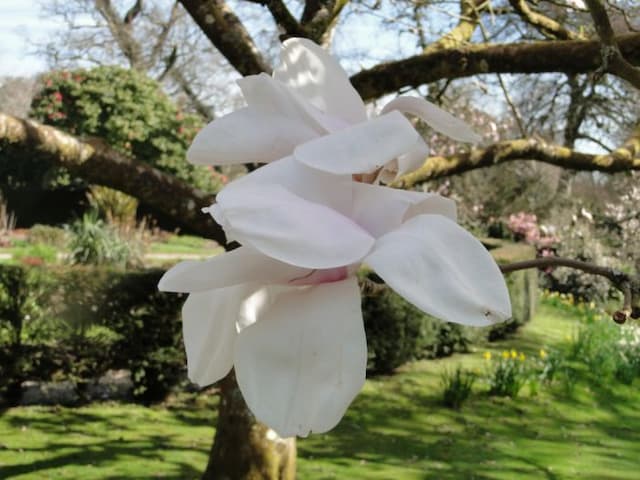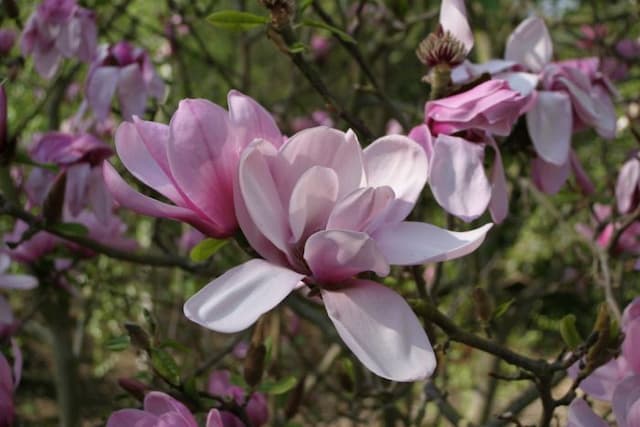Banana Split Magnolia Magnolia 'Banana Split'

ABOUT
The Magnolia 'Banilla Split' is a captivating plant characterized by its large, showy flowers that emit a delightful aroma reminiscent of bananas, hence the name 'Banana Split'. The flowers are creamy to slightly yellow on the inside, producing a visual effect that ties into its dessert-inspired name. Each bloom boasts a lush, full shape, usually with multiple petals that open wide and create an elegant display. Foliage on the 'Banilla Split' is also an attractive feature, with glossy green leaves that provide a striking backdrop to the flowers. The leaves often have an elongated oval shape and may display a leathery texture, adding to the plant's overall aesthetic appeal. New leaf growth may exhibit a lighter, more vibrant green, contrasting with the darker mature leaves. The branching habit of the Magnolia 'Banana Split' lends itself to a balanced and often symmetrical appearance, contributing further to its ornamental value. As a garden specimen, the 'Banana Split' magnolia creates a focal point with its sumptuous blooms and refreshing scent. Its appearance evolves gracefully through the seasons, making it a dynamic addition to any plant collection or landscape.
About this plant
 Names
NamesFamily
Magnoliaceae
Synonyms
Banana Split Magnolia
Common names
Magnolia 'Banana Split'.
 Toxicity
ToxicityTo humans
Magnolias, including the 'Banana Split' cultivar, are not considered toxic to humans. Therefore, ingesting parts of this plant typically does not result in poisoning or the manifestation of toxic symptoms. However, it is always advisable to avoid eating parts of ornamental plants due to potential individual sensitivities or the use of pesticides.
To pets
Magnolias, such as the 'Banana Split' magnolia, are generally recognized as non-toxic to pets. Ingesting this plant should not cause poisoning in animals like dogs and cats. That being said, individual animals may have varying sensitivities, and consuming plant material may sometimes lead to mild gastrointestinal upset simply due to the ingestion of non-food items. It's still a good practice to prevent pets from eating ornamental plants to avoid potential complications.
 Characteristics
CharacteristicsLife cycle
Perennials
Foliage type
Deciduous
Color of leaves
Green
Flower color
Yellow
Height
20 feet (6 meters)
Spread
15 feet (4.5 meters)
Plant type
Tree
Hardiness zones
7
Native area
Southeastern United States
Benefits
 General Benefits
General Benefits- Aesthetic Appeal: Magnolia 'Banana Split' has showy, cream-colored flowers with a unique banana-like scent, which makes it a striking addition to gardens and landscapes.
- Shade Providing: The broad canopy of the plant offers shade in sunny gardens, creating a cooler microclimate for humans and wildlife.
- Wildlife Habitat: It provides habitat and food for a variety of wildlife, including birds and beneficial insects.
- Seasonal Interest: This magnolia has a long blooming period in the spring, adding interest to the garden during this time.
- Low Maintenance: Once established, Magnolia 'Banana Split' requires minimal care, making it a convenient choice for gardeners with limited time.
 Medical Properties
Medical PropertiesThis plant is not used for medical purposes.
 Air-purifying Qualities
Air-purifying QualitiesThis plant is not specifically known for air purifying qualities.
 Other Uses
Other Uses- Artistic Inspiration: Magnolia flowers serve as a muse for artists and photographers aiming to capture their large and vibrant blooms in various mediums.
- Fabric Dyes: The petals can be used to create natural dyes for fabrics, offering a range of colors depending on processing techniques.
- Handmade Paper: Magnolia leaves and flowers can be incorporated into the paper-making process to create textured and decorative paper for crafts.
- Educational Tools: Magnolia cones and seeds can be used in educational settings to teach botany and the lifecycle of flowering plants.
- Culinary Experiments: Although not common for this variety, some magnolia petals are edible and can be experimented with in culinary arts for their unique flavor and presentation.
- Aromatherapy: Using essential oils extracted from magnolia flowers, one can create an atmosphere conducive to relaxation or meditation.
- Perfumery: Magnolia 'Banana Split' could potentially be used to create exclusive, boutique scents for perfumes due to its unique fragrance.
- Festival Decorations: In some cultures, magnolia blooms might be used in festivals or ceremonies as decor due to their large, impressive appearance.
- Floral Art: The large petals and leaves of magnolia can be used for floral art creation, such as pressing or framing for decorative purposes.
- Photographic Subjects: The unique beauty of the 'Banana Split' magnolia can be a compelling subject matter for specialized botanical photography, capturing the nuances of its flowers and foliage.
Interesting Facts
 Feng Shui
Feng ShuiThe Magnolia is not used in Feng Shui practice.
 Zodiac Sign Compitability
Zodiac Sign CompitabilityThe Magnolia is not used in astrology practice.
 Plant Symbolism
Plant Symbolism- Perseverance and Endurance: Magnolias are known to be tough and resilient, often one of the first plants to bloom in spring, symbolizing the ability to endure difficult conditions.
- Nobility and Dignity: The magnolia's large and showy flowers represent a sense of grandeur and an aristocratic bearing, indicating self-respect and pride without arrogance.
- Feminine Beauty: Magnolias have often been associated with the soft, delicate, and beautiful aspects of femininity.
- Purity and Innocence: The white flowers of certain magnolia varieties can represent purity and cleanliness, often used in religious and wedding ceremonies to symbolize innocence.
- Peace and Tranquility: The inviting and calming appearance of the magnolia promotes a sense of peace and is often used in spaces meant for reflection and relaxation.
 Water
WaterThe Magnolia 'Banana Split', commonly known as Banana Split Tulip Tree, should be watered thoroughly, ensuring the soil is moist but not waterlogged. During the first few years of establishment and in the growing season, it's important to water it once a week with about 1.5 gallons, especially if the weather is dry. Mature trees require less frequent watering, but make sure to provide deep watering every two to three weeks, as Magnolias prefer consistent moisture. Adjust your watering schedule during rainy periods to prevent overwatering. In hot summer months, you may need to water more frequently to maintain proper soil moisture.
 Light
LightThe Banana Split Tulip Tree thrives best in full sun to partial shade. It should be planted in a location where it can receive at least four to six hours of direct, unfiltered sunlight per day. The ideal spot is one that gets morning sun and some afternoon shade, especially in hotter climates, to protect it from the intense heat of the late day.
 Temperature
TemperatureThe Banana Split Tulip Tree prefers temperate climates and performs well in a range of temperatures. The ideal temperature for this plant is between 70°F and 85°F, but it can withstand minimum temperatures down to about -20°F. However, it's important to protect younger trees from extreme cold as they can be more susceptible to frost damage.
 Pruning
PruningThe Banana Split Tulip Tree should be pruned to maintain shape and remove any dead or damaged branches. The best time to prune is late winter or early spring before new growth starts. Pruning once a year is sufficient, focusing on light thinning to keep the tree healthy and attractive. Avoid heavy pruning as it can stress the tree.
 Cleaning
CleaningAs needed
 Soil
SoilThe Banana Split Magnolia requires well-draining, nutrient-rich soil with a slightly acidic to neutral pH ranging from 5.5 to 7.0. A good mix could be equal parts loam, peat moss, and perlite or pine bark to ensure proper drainage and fertility.
 Repotting
RepottingBanana Split Magnolia trees do not require frequent repotting; they can be repotted every 3-5 years. Younger trees may need repotting more often to accommodate rapid growth.
 Humidity & Misting
Humidity & MistingBanana Split Magnolias thrive best in moderate humidity levels. These trees prefer outdoor environments where the natural humidity supports their growth.
 Suitable locations
Suitable locationsIndoor
Provide bright light and keep soil moist.
Outdoor
Plant in partial shade, shelter from strong winds.
Hardiness zone
7-9 USDA
 Life cycle
Life cycleThe Magnolia 'Banana Split' begins its life cycle when a seed germinates, usually in the spring following a period of stratification, which helps to break the seed's dormancy. After germination, the seedling stage commences, characterized by the development of the plant's first leaves and root system. As it enters the growth stage, the plant develops a woody stem and a robust root structure; foliage becomes more plentiful, and it may take several years to mature fully and be ready for reproduction. The flowering stage follows, during which the magnolia produces large, aromatic flowers – typically blooming in late winter to early spring before the leaves unfurl. After pollination, usually by beetles attracted to the flowers, the plant develops fruit (an aggregate of follicles) that matures and releases seeds in late summer to fall, completing the reproductive cycle. The cycle is perennial, with the plant going dormant in winter and resuming growth in the following spring, continuing for many years as the tree grows and matures.
 Propogation
PropogationPropogation time
Spring-Early Summer
The Magnolia 'Banana Split', known for its striking flowers and sweet fragrance, is best propagated in late winter or early spring before the new growth starts. One of the most popular methods is by softwood cuttings. A softwood cutting is taken from new growth that is not yet firm at a length of about 6 to 8 inches (15 to 20 cm). It is essential to make a clean cut just below a node and remove the lower leaves. The cutting should then be dipped in rooting hormone to encourage root development and planted in a well-draining soil mix. The cutting needs to be kept moist but not waterlogged and should be placed in indirect light until roots have established, after which it can be transplanted to a more permanent location.








![Magnolia [Felix Jury]](/_next/image?url=https%3A%2F%2Fplants-admin.emdemapps.com%2Fimages%2Fplants%2F%2Fimages%2F604b61a0b23b7.png&w=640&q=75)
